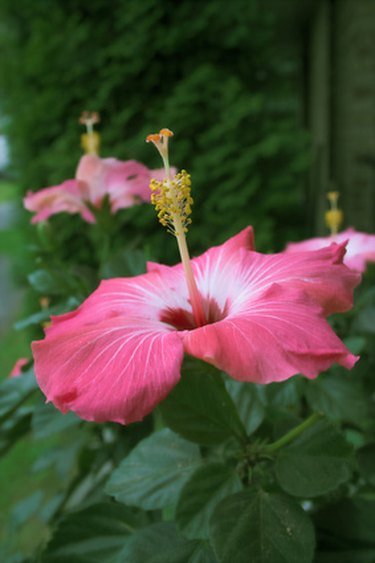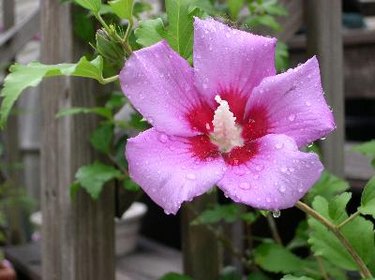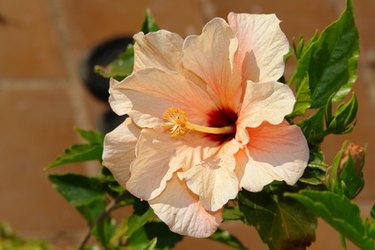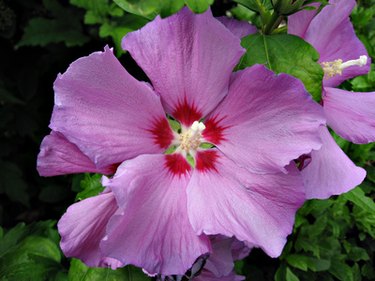
Evoking a sensual tropical look, the flowers of both the Chinese hibiscus (Hibiscus rosa-sinensis) and the rose-of-Sharon (Hibiscus syriacus) add bold visual interest to a garden. These two species are close relatives -- both are members of the mallow family, Malvaceae. Horticulturists and breeders developed numerous cultivars of both shrubs, increasing the number of ornamental plants with particularly showy flower colors.
Origins
Video of the Day

The Chinese hibiscus' nativity is obscure since it's been bred for centuries, initially by the Chinese. Botanists believe the species originated in tropical southern Asia, likely southern China, as a red-flowering shrub. The rose-of-Sharon also hails from China, but at higher elevations with subtropical to temperate climates. Literature may cite this shrub is native to the Middle East, but Flora of China notes that this ornamental shrub was spread along trade routes from the Far East across other parts of Asia.
Video of the Day
Growth Habit

Chinese hibiscus shrubs mature anywhere from 3 to 10 feet tall and equally as wide. Typically they look rounded or as upright ovals. Modern cultivars display variable growth habits, from sprawling mounds to open or dense ovals. Rose-of-Sharon plants become more erect but oval in comparison. They mature anywhere from 5 to 14 feet tall and 4 to 10 feet wide.
Foliage

Chinese hibiscus foliage is evergreen. Each glossy green leaf blade looks oval or like a broad-lance. The leaf edges display a few small teeth. A common size is up to 6 inches long. By contrast, rose-of-Sharon leaves are winter-deciduous. The green leaf varies in shape from broad ovals to triangular or diamond-shaped, sometime with three shallow lobes. Coarse teeth line the edges. Rose-of-Sharon leaves are smaller, maturing up to only 4 inches long.
Flowering

Flowers occur on Chinese hibiscus any time of year, as long as weather remains warm. The flower comprises five petals that spread wide and flat around a slender floral tube. The solitary blossoms grow from twig and branch tips. Rose-of-Sharon flowering happens from midsummer to mid-fall. The flowers resemble trumpets with five petals, and eventually open wide, but not nearly so as those of the Chinese hibiscus. Rose-of-Sharon flowers develop singly or in pairs, rising from the bases of leaves anywhere on sun-exposed branches. Often the flower center is a contrasting darker shade of pink or red and the stamens are white. Flower colors of both species' cultivars is highly variable and diverse.
Plant Hardiness
Grow Chinese hibiscus outdoors where frosts and freezes don't occur. They are best suited for U.S. Department of Agriculture plant hardiness zones 10 and warmer. Temperate-zone gardeners enjoy rose-of-Sharon because it survives significant winter cold in comparison. Grow it across USDA zones five through nine.